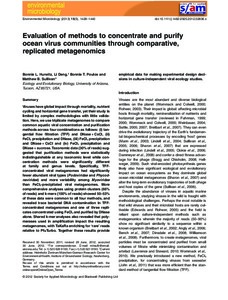| dc.contributor.author | Hurwitz, Bonnie L. | |
| dc.contributor.author | Deng, Li | |
| dc.contributor.author | Poulos, Bonnie T. | |
| dc.contributor.author | Sullivan, Matthew B. | |
| dc.date.accessioned | 2019-01-10T16:25:07Z | |
| dc.date.available | 2019-01-10T16:25:07Z | |
| dc.date.issued | 2013 | |
| dc.identifier.citation | Hurwitz, B. L.,; Deng, L. ; Poulos, B. T. and Sullivan, M. B. (2013) Evaluation of methods to concentrate and purify ocean virus communities through comparative, replicated metagenomics. Environmental Microbiology, 15, pp.1428-1440. DOI:10.1111/j.1462-2920.2012.02836.x | en_US |
| dc.identifier.uri | http://hdl.handle.net/11329/643 | |
| dc.identifier.uri | http://dx.doi.org/10.25607/OBP-202 | |
| dc.description.abstract | Viruses have global impact through mortality, nutrient cycling and horizontal gene transfer, yet their study is limited by complex methodologies with little validation. Here, we use triplicate metagenomes to compare common aquatic viral concentration and purification methods across four combinations as follows: (i) tangential flow filtration (TFF) and DNase + CsCl, (ii) FeCl3 precipitation and DNase, (iii) FeCl3 precipitation and DNase + CsCl and (iv) FeCl3 precipitation and DNase + sucrose. Taxonomic data (30% of reads) suggested that purification methods were statistically indistinguishable at any taxonomic level while concentration methods were significantly different at family and genus levels. Specifically, TFF‐concentrated viral metagenomes had significantly fewer abundant viral types (Podoviridae and Phycodnaviridae) and more variability among Myoviridae than FeCl3‐precipitated viral metagenomes. More comprehensive analyses using protein clusters (66% of reads) and k‐mers (100% of reads) showed 50–53% of these data were common to all four methods, and revealed trace bacterial DNA contamination in TFF‐concentrated metagenomes and one of three replicates concentrated using FeCl3 and purified by DNase alone. Shared k‐mer analyses also revealed that polymerases used in amplification impact the resulting metagenomes, with TaKaRa enriching for ‘rare’ reads relative to PfuTurbo. Together these results provide empirical data for making experimental design decisions in culture‐independent viral ecology studies. | en_US |
| dc.language.iso | en | en_US |
| dc.rights | Attribution-NonCommercial 2.5 | * |
| dc.rights.uri | http://creativecommons.org/licenses/by-nc/2.5/ | * |
| dc.title | Evaluation of methods to concentrate and purify ocean virus communities through comparative, replicated metagenomics. | en_US |
| dc.type | Journal Contribution | en_US |
| dc.description.refereed | Refereed | en_US |
| dc.format.pagerange | pp.1428-1440 | en_US |
| dc.identifier.doi | 10.1111/j.1462-2920.2012.02836.x | |
| dc.subject.parameterDiscipline | Parameter Discipline::Biological oceanography::Bacteria and viruses | en_US |
| dc.bibliographicCitation.title | Environmental Microbiology | en_US |
| dc.bibliographicCitation.volume | 15 | en_US |
| dc.bibliographicCitation.issue | 5 | en_US |
| dc.description.eov | Microbe biomass and diversity | en_US |
| dc.description.bptype | Best Practice | en_US |
| dc.description.bptype | Manual | en_US |
| obps.contact.contactemail | mbsulli@email.arizona.edu | |
| obps.resourceurl.publisher | https://onlinelibrary.wiley.com/doi/full/10.1111/j.1462-2920.2012.02836.x | en_US |
 Repository of community practices in Ocean Research, Applications and Data/Information Management
Repository of community practices in Ocean Research, Applications and Data/Information Management

